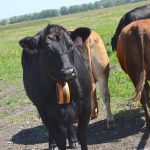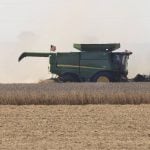Timing is key when using glyphosate to dry greenfeed before cutting and baling.
Two rangeland and forage agrologists with Saskatchewan Agriculture have conducted demonstration projects in two areas of the province since 2001 with different weather. Their results were different and they may reveal the most important part of the process: timing.
“The objective of our projects was to determine the effect glyphosate had on the yield and quality of oat and barley greenfeed,” said Allan Foster at Tisdale.
He conducted his trials with Agriculture Canada staff at the Melfort Research Centre, while Lorne Klein of Weyburn carried out his project with farmers at Wawota, Balcarres, Francis, Corning and Carievale.
Read Also

Why feds imposed EV tariffs
Moe and Kinew have a fight on their hands when it comes to eliminating the EV tariff. Canada has to worry about pissing off the U.S. and Mexico and hundreds of thousands of auto workers.
Foster said annual cereal crops to be baled are now cut with either a swather or mower conditioner in the soft dough stage. The windrow is often slow to dry, and may require turning before it can be baled. It is also exposed to rain.
“The newer option is to spray the crop in the soft dough stage with glyphosate. The crop is allowed to stand until it is dry, then it is cut and baled. This method decreases harvest risk and allows the producer to schedule harvest. Added benefits are perennial weed control and reduced cutting cost if feed can be cut with a swather instead of a mower conditioner.”
Klein said there are also disadvantages, such as cost of the glyphosate, lack of regrowth for fall grazing, and the need for a high clearance sprayer.
To date, however, the results from his project suggest that producers now have a new option for drying greenfeed before baling.
“After spraying with glyphosate, dry matter yield increased slightly until dry enough for baling, and then returned to pre-glyphosate level. Crude protein decreased one to 1.5 percentage points from spraying to drydown, while the total digestible nutrients – energy – of oats increased six to eight percentage points from spraying to drydown.
“The economic tradeoff of these protein and energy changes, however, is about equal at current feed costs. The energy of the barley did not increase, but further trials are needed to determine if barley reacts differently than oats to this treatment.”
Klein said producers who were feeding beef cows observed that yellowfeed is as palatable as greenfeed.
The results from the replicated plots of oats and barley at Melfort were not so positive. Spraying with glyphosate slightly reduced yield in 2001 and significantly reduced it in 2002. In both years, protein and TDN were slightly lower in the sprayed crops than in the unsprayed crops
“The procedure we followed was slightly different than that in the southern part of the province, but I think the biggest reason for the differences is timing,” Foster said.
“If the crop is sprayed too early, yield is lost.
“You have to spray close to the soft dough stage. So, at this point, I think the use of glyphosate to dry greenfeed prior to cutting and baling works, but timing is very important.”
Foster and Klein are continuing their yellowfeed trials this year. For more information on their results to date, phone Foster at 306-878-8890 and Klein at 306-848-2382.














